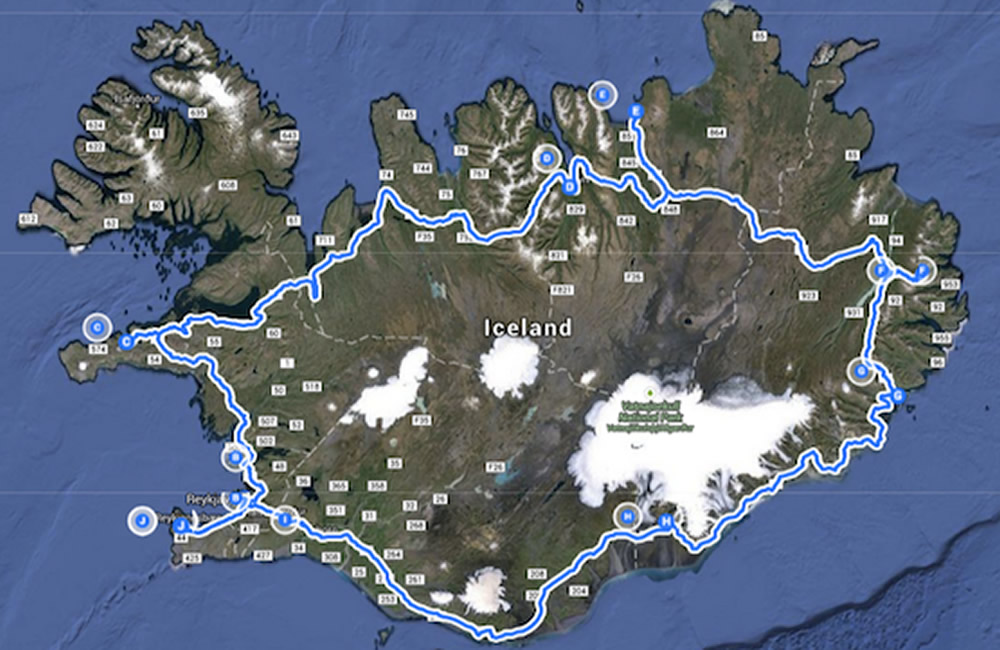Choosing a travel guide is never an easy task. The best would be to buy all of them or, at least, go to a library and go through the most of them, before deciding. For our trip to Iceland went for the Rough Guide, just for a change, as it served us well in Warsaw. Since we were driving a car we also needed to buy a detailed map.
Our Iceland Road Map
We were expecting to consult our map outdoor, under extreme weather conditions, the paper torn apart by strong gales and battered by icy rain. This never happened but we decided to buy a waterproof and tearproof map, one of the folding type. We would have preferred a book map, much easier to use inside the car, but the difference of price between the two models was high enough to influence the choice. I would now go for the book map, or for more detailed regional maps as details can be significative when you’re lost in the middle of nowhere with nobody to ask directions to. Check our article for more tips about maps and driving in Iceland.

Iceland Travel Guides
Our Rough Guide let us down in few occasions. The Snaefellsnes peninsula was described as a collection of eventless towns, wooden churches and rocks, while our host in Grundarfjordur penned down for us an unforgettable one-day itinerary.
In the Myvatn region we were massively disappointed as we missed out on this just because it wasn’t clearly described and it wasn’t on the map. Talking about guides with a couple, whose path we crossed a few times along the road, they had the same feedback about their Lonely Planet. Sure we might have got all the hints if we had read the guide thoroughly but I reckon guides should be thought for being consulted quickly on the go.
They can be found at any tourist information centre of the country, I started collecting them even if we initially thought they were just an excuse to advertise local hotels and restaurants. As a matter of fact they turned out to be incredibly useful, rich of details on the area they cover, from the most popular destinations, to the best activities, to some precious info that wasn’t on our Rough guide. They’re for free and can also come with an extra folding maps which, even though is not quite as detailed, have been very helpful to us in several occasions.
Self-drive tours
Before planning the trip ourselves, we’ve contacted some companies organising self drive tours. They are pretty cool as they organise everything for you but they are not intrusive (which we hate) so, once you’re there, you’re on your own and you are completely free, either to stick to the plan or to go off route. Their offer includes: car rental, accommodation booking, maps, suggestions, GPS, assistance. Considering the costs in Iceland, what those guys charge is perfectly acceptable for a nicely planned trip and a safety net. However it was above our budget so we decided to do it on our own.
The companies we contacted, that seemed professional and reliable, are the Reykjavik based Extreme Iceland and Discover the World.
Car rental
First thing we had to get the car sorted. After reading countless forums and blogs we picked Blue Car Rental as our company of choice. It appears to be one of the cheapest and one of the most reliable with smashing reviews. They also offer some older model for a cheaper price (like the guys at SADcars do) so we opted for a Jimmy. If you are not going to use the “difficult” roads, called F-roads, you really don’t need a 4×4 but, since this model costs only little more than small car we opted for a 4×4. And also we figured it’d be cool to drive a car called Jimmy. Different combinations of days – for pick up and drop off – and location – either Keflavik or Reykjavik – can change the final bill massively. Moreover those companies usually offer a transfer service so they will come pick you up wherever you are and they’ll take you where you need to go after you’ve given the car back.
Booking Accommodation
This has proven harder than we thought. With few properties, and far between, there’s no much choice in Iceland for a bed to sleep, especially if you’d rather choose for a lower budget. To make things worse the tour operators book, at the beginning of the season, as many rooms as they think they’ll need, leaving even fewer options for the independent traveller, especially in busy areas such as near the Skaftafell National Park. For this reason we recommend to book every night, largely in advance, unless you have a camping kit as a back up plan.
We’ve booked a mix of rooms in hotels and guesthouses on Booking.com, and AirBnB. We’ll stay in a wooden cabin and in a vintage van parked in a back yard of a house overlooking a fjord… not sure whether to look forward to that or be scared.
Given the nature of this country and the scarcity of accommodation I highly recommend to contact every property booked, asking for confirmation of availability and if the location is correct. A room booked on AirBnB turned out to be in Reykjavik, not near Akureyri as shown on their map. Luckily we found out before leaving and not once there, in the middle of nowhere.

Leave a Reply